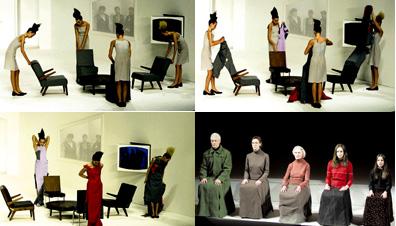|
|
 |
Fashion &
Design |
| |
Hussein
Chalayan |
|
 Turkish Cypriot fashion designer
Hüseyin Çaglayan (aka Hussein
Chalayan) was born in Nicosia, in 1970. Turkish Cypriot fashion designer
Hüseyin Çaglayan (aka Hussein
Chalayan) was born in Nicosia, in 1970.
He graduated from Nicosia's Türk Maarif College, and later studied design in
London. While finishing his studies at the Central St. Martin’s School of Art in 1993, his senior year collection, “The Tangent Flows“, was displayed in Browns windows.
In 1995, Chalayan beat 100 competitors to clinch a top London fashion design
award. In the contest, organised by the company "Absolut", Chalayan, aged 25,
won financial backing to the tune of UK Pounds 28,000 to develop creations for the British capital's Fashion Week in October 1995.
Along with his own line, he also recently designed for TSE knitwear. His personality is calmer than his fellow British designers, yet his shows can be thought provoking and intense. His designs, which can be based on experiments and even abstractions of existing items such as meteorological charts, are often minimal and elegant.
Twice named 'British Designer of
the Year', Chalayan also won
much praise from trade publications around the world.
 |
|
Chalayan's
winner show at the British Fashion Week
|
|
| |
|
| |
|

|
| Chalayan
with top models and celebrities |
|
| |
|
 |
Hussein
Chalayan - A Millenial Maverick |
|
(article
appeared in Elle magazine) |
| |
|
| |
|
.jpg)
|
|

|
| Photos
by Alaistair Grant (AP) |
Turkish-Cypriot
designer Hüseyin Caglayan (better known to fashion fans as
Hussein Chalayan) was born in Nicosia in 1970. After graduating
from the Türk Maarif College in his homeland, Chalayan went on
to study at London's prestigious Saint Martin's School of Art.
Regarded as something of a mad professor, Chalayan was
frequently seen around the college with a plastic bag full of
books on philosophy, architecture and physics. His studies and
interests were so diverse and removed from those of typical
fashion students that one professor actually told him to switch
to sculpture.
A clever
designer who shuns the type of attitude that is a virtual
prerequisites to enter the fashion haute monde, Hussein Chalayan
is a visionary who simultaneously charts new fashion territory
and turns out pieces with staying power. In an industry obsessed
with change, this is no small achievement.
Says bad boy
designer Alexander McQueen, "I admire his aesthetically
challenging mind." And despite maintaining a certain
distance from pop-culture and fashion trends, Chalayan has
displayed an uncanny ability to present spot-on collections
season after season. For his own line, Chayalan pleases crowds
with what can only be described as future minimalism. His
collections have become as much art installation and theater as
fashion, and his understanding of the intricacies of
architecture lends itself to well-articulated but minimal
silhouettes. He has made waves with an 'inspired' look at the
traditional Muslim garb (naked models paraded down the catwalk
with their heads draped in traditional scarves); other creations
include long knitted dresses with built-in walking sticks,
starkly pleated ‘concertina’ dresses and course, the
infamous cone-and-perspex-cube headdresses.
If Chalayan's
work is highly individual, it’s because the designer avoids
borrowing from fashion history: "I was never a fashion
magazine nerd", he told Elle in a recent interview.
Chalayan has produced three ultra-feminine (and remarkably
wearable) collections for the New York-based cashmere company
TSE.
"What
Hussein has done," says Rebecca Shafer, creative director
of TSE, "is to make a commercial collection with a pure
design focus. He pays attention to detail, but the finished look
is very simple. It's a very intellectual approach."
Chalayan also creates a young, fast and disposable capsule
collection for Top Shop in London, a store popular with
teenagers. At present, he is designing an installation for the
'Mind' section of London's controversial Millennium Dome. And
Colette - the Parisian mecca for all that is trendy -doesn't
just sell his clothes, it exhibits them!
|
| |
|
| |
 |
| A
Chalayan's work on the cover of Cornucopia |
1993,
Chalayan's graduation collection featured clothes that had been
buried, exhumed and covered in lead shavings to see how they
would react to a magnetized catwalk. But the mantle of
eccentricity was dispelled when Joan Burstein, owner of Browns,
the cutting edge clothes boutique in London, chose to display
Chalayan’s entire collection in her shop window. "It was
his complete dedication that attracted me to his work," she
said, "He had that blind self-belief that's inherent in all
great designers." Not surprisingly, a star was born.
Chalayan's
career was off and running: in 1995 he topped 100 rivals to
clinch a contest organized by Absolut Vodka, which gave him
financial backing to develop creations for London Fashion Week.
Now Chalayan has 10 collections to his credit. Innovations from
unrippable paper clothes, super-sharp suits with illuminated
flight path patterns and pixilated print dresses serve to
highlight technology-inspired fashion as a vital element for
contemporary dressing.
Last year, at
28, Chalayan was honored with the prestigious Designer of the
Year award at this year’s annual British Fashion Awards. From
his cramped studio near Covent Garden, Chalayan has developed a
reputation for being a serious man of ideas who avoids fashion’s
social circuit like the plague, preferring a spot of Heidegger
to the 'it' clubs. Such modesty and talent has earned the
admiration of many fashion VIPs. "I like his attitude and
way of thinking," comments the ultra-elusive Rei Kawakubo
of Comme des Garçons. |
| |
|
| |
Arts
& Culture |
| |
|
|
 |
|









